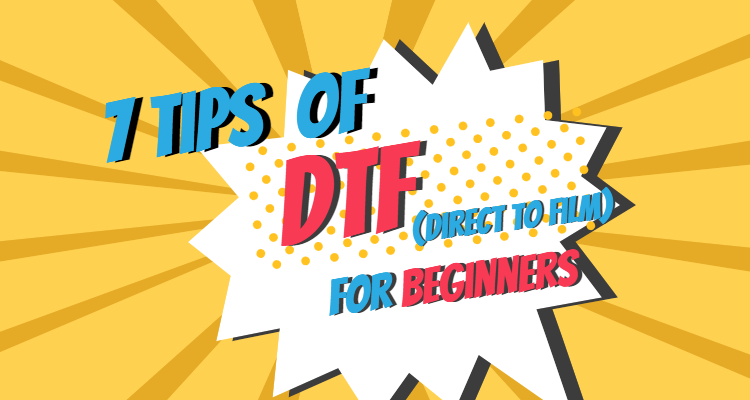DTF (Direct to Film) has been around for a while, but its usage is just recently becoming widespread. Using the DTF printing option might not be so easy to understand as a beginner, but not when you are equipped with the right knowledge. Here are 7 tips to help you understand better how to get a quality output.
1) Opt for quality DTF pieces of equipment
For any printing venture you are venturing in, it is important to know that the more quality your equipment is, the more the quality of your work and output. This is more of a strict rule in DTF printing as you can only get a quality output only if quality work tools are used. Ranging from your DTF ink to your DTF ink and DTF paper. Other tools that need to be of quality include DTF powder adhesive, DTF transfer printer machine, etc. High-quality DTF ink is important so that the printhead won’t clog. Thereby, it is highly advisable to go for inks that are specially formulated for direct-to-film printing.Ensure you check that your DTF powder adhesive is quality as well so that your output can boast of durability while having a soft transfer feeling. Also, there will be no foul smell but a good storage option. A good recommendation for a DTF transfer printing machine is the 11800 DTF /transfer printer. Invest in getting Quality Supplies for your DTF printing to attract more clients to you.
2) Usage of DTF film
You can only use a DTF film once. If you are planning to use your DTF film multiple times as a beginner, then cancel that idea. This is because DTF film cannot be used again after it has been used once. There is a coating on the DTF film and it will have been used up when you are printing and using it for the first time. This coating is a basic factor that determines the extent of the ink absorption and the quality of the final printing. If you try to reuse it again, the ink will keep flowing off instead of sticking to the garment. You could print the patterns at once in the film, then cut the one you to transfer.
3) Do not interchange DTG ink for DTF ink
You might wonder whether you can use DTG ink on a DTF printer. Do not waste resources by trying this out, because you wouldn't get a favorable or quality output. You cannot use a DTG ink on a DTF printer because the chemical formulations of both inks are different. DTF inks are water-based and their formulation can only react with DTF film and powder during heating.
4) Your DTF dryer is fragile
The DTF dryer is fragile and easy to break, hence, handle with care. The most fragile thing in the dryer is the heating lamp and once it breaks, the machine becomes hard to work with. Ensure that you take all the necessary precautions according to the manufacturer’s instructions. Always confirm the voltage of the powder shaker and make sure that the voltage in the working environment is suitable to work with. Extreme temperatures of the heating lamp can cause the overheating of the lamp. Once the heating lamp is damaged, there will be poor connection and disconnection in the power contact of the heating element.
5) Use the correct photography resolution
One great thing about DTF printing is that it allows its users to embrace the use and beauty of photography. However, it is important to note that one way to make the beauty of your photography artwork come out well on DTF printing is by working with a high resolution during printing.
DTF enables you to enjoy full-color printing, hence, you can print on your piece of fabric any type of image, artwork, or photograph. This provides you with the opportunity to work on a wide range and different alternatives of custom and personalized layouts for your customers. The higher the resolution of your artwork, the shaper, and clearer your artwork will be.
Photographs are raster images and to get the best quality print, they have to be created with a higher resolution like 300 DPI with the photograph at its actual size. However, if you are using the artwork for many locations at different sizes, you can set out by firstly having a layout that is at the market’s size, before reducing it for smaller applications. Low-resolution pictures are best suited for web designs and are usually 72 DPI.
6) Design software flexibility
For the use of different design software, DTF printing allows any type with no limitation or selective feature. Some common examples of design software for vector images include Corel draw and adobe illustrator. For raster artwork editing, some common examples that can be used for your artwork include core photo paint and Adobe Photoshop.
Your design software isn't limited to these only, other options aren’t so common that you can try out. Some of this software include affinity photo which is good for raster designs and affinity design which is suitable for vector design, transfer expresses easy view designer, etc.
As long as you can have the proper file format of these works and can send them to your printer with the correct resolutions, you can always use them for your artwork editing and design. Unlike other transfer or printing options that would selectively choose which design software will come out good in them, DTF stands out in this aspect. Therefore, as a beginner, experiment with these design software to know more about the one that will suit you.
7) Beware of color variations in different systems
It is highly recommended that you pay attention to the colors you will use for your design. This is because the way colors come out ranges from printer to printer and from monitor to monitor. Hence, it is better to have a realistic color representation that will always come out nice irrespective of the system used for its output.
A great recommendation is to use the RGB setting because it offers a wider variety of color gamut which will come out well on a DTF printer since a DTF printer uses CMYK. Another great option to better help manage the color of your design is a planting bridge book. Pantone bridge book functions by showing you the Pantone color plus the color, which is directly next to it as processed by CMYK.
Alternatively, some DTF companies present personalized color palettes. This is a great advantage because asides from that it offers designers different options of colors to work with, or for your customers to choose from, it also guarantees that you get the same printed result as the same result you got from your monitor view while designing the artwork.
With these tips above, you will have a great time dealing with your DTF machine. CIAO!


